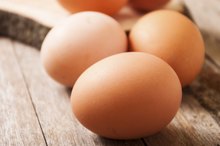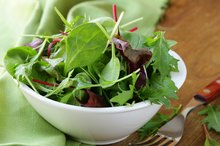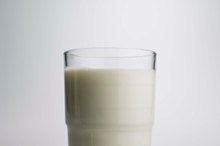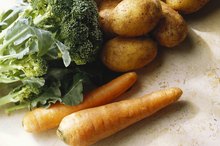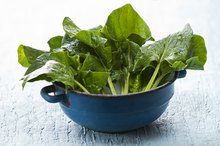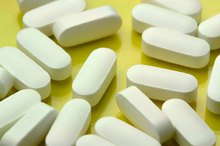The Amount of Calcium and Magnesium for a 70-Year-Old Woman
Minerals play vital roles in the regulation of enzymes, hormones and the function of vitamins. Calcium and magnesium are both major minerals, or those that your body requires in excess of 100 mg each day. Calcium serves as a key component in the structure and formation of bones and teeth, and it also helps form blood clots and regulate nerve transmission. Magnesium primarily helps activate enzymes needed to synthesize protein. While it's commonly known that the lack of estrogen in postmenopausal women increases the risk of osteoporosis, resulting in increased calcium needs, older women may be at risk of magnesium deficiencies and should pay special attention to obtaining plenty of this mineral as well.
Calcium Recommendations
The Food and Nutrition Board of the Institute of Medicine maintains dietary reference intakes, or DRIs, for all vitamins and minerals across all ages and sexes. As of June 2011, the recommendation for calcium for women 70 and older is 1,200 mg a day. This value is slightly higher than the DRI of 1,000 mg for a 70-year-old male.
Calcium Sources
Zinc, Magnesium & Vitamin B6
Learn More
Calcium is commonly found in dairy products, such as milk and cheese. Dark green vegetables and legumes are also a rich source of this major mineral. According to the USDA's National Nutrient Database for Standard Reference, the richest sources of calcium are fortified breakfast cereals, with over 1,000 mg per servings that range from 3/4 to 1-1/3 cup. Because many people cannot digest the lactose found in dairy products, fortified products and vegetables offer sufficient calcium substitutes.
- Calcium is commonly found in dairy products, such as milk and cheese.
- Because many people cannot digest the lactose found in dairy products, fortified products and vegetables offer sufficient calcium substitutes.
Magnesium Recommendations
Certain medications lower caloric intake, and a reduced ability to absorb magnesium in the liver place older women at an increased risk of magnesium deficiency, according to the Office of Dietary Supplements of the National Institutes of Health. The current DRI for magnesium for a 70-year-old woman is 320 mg a day.
Magnesium Sources
Magnesium for Menopause
Learn More
The best dietary sources of magnesium, according to "Essentials of Exercise Physiology," are whole grains and green leafy vegetables. According to the USDA, buckwheat flour, bulgur and oat bran are the richest natural sources of magnesium, with 301, 230 and 221 mg, respectively, per cup. Snacks and candies that contain chocolate also have high amounts of magnesium. Other common sources of magnesium include fish, beans, tomato products and nuts.
- The best dietary sources of magnesium, according to "Essentials of Exercise Physiology," are whole grains and green leafy vegetables.
Related Articles
References
- "Essentials of Exercise Physiology"; William D. McArdle, et al.; 2006
- U.S. Department of Agriculture; National Nutrient Database for Standard Reference, Release 18; Nutrient Lists; 2009
- Office of Dietary Supplements, National Institutes of Health; Dietary Supplement Fact Sheet: Magnesium; July 2009
- Rosanoff, A., Weaver, C. M., & Rude, R. K. (2012). Suboptimal magnesium status in the United States: are the health consequences underestimated?. Nutrition Reviews, 70(3), 153-164.
- Dupont, C., Campagne, A., & Constant, F. (2014). Efficacy and safety of a magnesium sulfateârich natural mineral water for patients with functional constipation. Clinical Gastroenterology and Hepatology, 12(8), 1280-1287.
- D'Angelo, E. K., Singer, H. A., & Rembold, C. M. (1992). Magnesium relaxes arterial smooth muscle by decreasing intracellular Ca2+ without changing intracellular Mg2+. The Journal of Clinical Investigation, 89(6), 1988-1994.
- Sojka, J. E. (1995). Magnesium supplementation and osteoporosis. Nutrition Reviews, 53(3), 71-74.
Writer Bio
Graham Ulmer began writing professionally in 2006 and has been published in the "Military Medicine" journal. He is a certified strength-and-conditioning specialist with the National Strength and Conditioning Association. Ulmer holds a Master of Science in exercise science from the University of Idaho and a Bachelor of Science in psychology from Washington State University.
